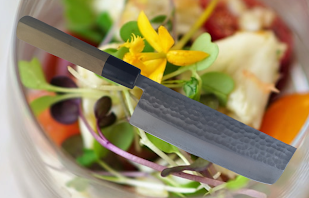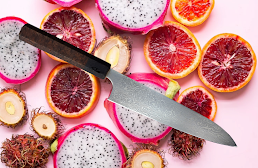The Art of Knife Sharpening
A Beginner's Guide
Knife sharpening isn't just a culinary skill—it's an art form. Honing the edge of your blade can rejuvenate your cooking, making slicing and dicing a breeze, and transforming meal prep into a delightful experience. Whether you're a professional chef or an amateur cook, mastering the basics of knife sharpening will elevate your culinary game. Let's delve into the essentials for beginners to navigate the sharpening process with ease.
Understanding Your Tools
Types of Sharpeners
- Whetstones: The most traditional method, using a block of stone of varying grits for sharpening. They require some skill and practice but offer the most control and best results.
- Manual Sharpeners: Easier for beginners, these sharpeners often have pre-set angles and slots to guide the knife through.
- Electric Sharpeners: The quickest and easiest method, ideal for those who value convenience. However, they offer less control compared to whetstones.
Choosing Your Sharpener
For individuals starting their journey in the art of knife sharpening, beginning with simple and user-friendly tools like a manual sharpener or a low-grit (about 1000) whetstone can be the ideal way to start. Here's why:
The Appeal of Manual Sharpeners
Manual sharpeners are specially designed with slots that hold the knife at the optimal angle for sharpening. They typically have two slots, one for coarse sharpening and another for fine honing. As a beginner, you won't need to worry about achieving the correct angle; the sharpener will do this for you. All you need to do is pass the knife blade evenly through the slot a few times, and voilà — your knife is sharp again!
These tools are compact, affordable, and easy to use, making them great for those who are new to sharpening or are looking for a quick, no-fuss sharpening method.
Why Opt for a Low-Grit Whetstone
Whetstones, on the other hand, require more technique but provide invaluable insight into the sharpening process, knife edges and the interaction between the blade and different materials.
Starting with a low-grit (about 1000) whetstone allows beginners to form a new cutting edge effectively. The coarser grit works more aggressively against the blade, helping to fix dull or damaged edges. As you slide your knife's edge along the wetted surface, you'll feel how the stone grinds against the steel, helping you understand the strength and angle necessary for an effective sharpen.
Furthermore, the process of using a whetstone can be therapeutic, inviting a mindful approach towards maintaining your tools. This can become a ritual, grounding you in the traditions of the culinary world, and offering a tactile connection to your cooking experience.
Understanding the Knife's Edge
By starting with these types of tools, you'll gain insights into the techniques of sharpening and start to understand the anatomy of your knife. Seeing and feeling how the edge interacts with different coarseness and materials will help you appreciate the intricacies of different blade characteristics.
In sharpening, you're refining the edge of your blade, and in doing so, you're learning about its bevel, its existing angle, and how different forces against the blade affect its sharpness. This knowledge will be highly beneficial as you progress from a beginner to someone more proficient in the art of knife sharpening.Preparing to Sharpen
Before you begin, it's essential to inspect your knife. Understand its current condition and what you aim to achieve—be it fixing a dulled edge or repairing small chips. For whetstone users, soaking the stone in water (check the manufacturer’s recommendation) until bubbles cease is crucial for a smooth sharpening process.
Sharpening Techniques
Whetstone Sharpening
- Finding the Angle: Hold the knife against the whetstone at a 20-degree angle for most kitchen knives. This angle is key to achieving a sharp edge.
- The Motion: With gentle pressure, glide the blade across the stone in a sweeping motion, from the tip to the base, ensuring to cover the entire edge.
- Consistency: Repeat this motion, maintaining the same angle and pressure throughout, usually around 10 strokes per side, or until you've formed a new edge.
Using Manual or Electric Sharpeners
To be fair, I don't really encourage electric sharpeners. However, if that's the path your on keep reading.
When it comes to sharpening your knives with either manual or electric sharpeners, precision and adherence to the manufacturer's guidance are paramount. Here's a structured approach to help you navigate the process effectively, preserving the integrity of your knives while achieving the desired sharpness.
Understanding the Tool
Before you even take your knife to the sharpener, it is crucial to read and comprehend the manufacturer's instructions. Each sharpener is designed differently and may require specific techniques to work correctly. Some sharpeners also include multiple stages for sharpening and honing the blade.
The Sharpening Process
Manual Sharpeners
For manual sharpeners:
- Positioning: Place the sharpener on a flat, stable surface, ensuring it won't slip as you work.
- Preparing the Knife: Make sure your knife is clean and dry. Any debris on the blade can affect the sharpening process.
- Starting the Sharpen: Hold the knife by the handle, starting with the heel (the part of the edge closest to the handle). Insert it into the designated slot at the appropriate angle as indicated by the sharpener's design.
- Even Pressure: Gently pull the knife towards you, applying consistent pressure from the heel to the tip of the knife. The motion should be smooth and controlled—too much pressure can damage the blade or the sharpener.
- Repetition: Repeat this process a small number of times, usually as recommended by the manual. In many cases, a few passes are enough to sharpen the knife effectively.
- Checking the Sharpness: After a few strokes, carefully check the sharpness of the knife. Do this by observing the blade in the light for a uniform reflection or by carefully and lightly running your thumb perpendicular to the edge (not along the edge, to avoid cutting yourself).
Electric Sharpeners
For electric sharpeners:
- Power and Stability: Ensure the sharpener is situated on a stable surface and plugged into an outlet (if required).
- Slot Selection: Many electric sharpeners have multiple stages. Usually, you'll start with the coarsest slot and move to the finer stages for honing.
- Inserting and Pulling Through: Turn on the sharpener if it has a switch. Insert the heel of the knife into the first slot, then gently pull the knife through to the tip with even, moderate pressure. Let the sharpener do the work—excessive force is unnecessary and deleterious.
- Number of Passes: Perform the recommended number of passes in each slot, then progress to finer stages if your sharpener has them.
- Final Check: After sharpening, evaluate the edge for sharpness as with the manual process.
A Word of Caution: The Risk of Over-sharpening
A common novice mistake is the belief that more sharpening will lead to a better edge. In reality, over-sharpening can wear down the blade prematurely and reduce its lifespan. With manual and electric sharpeners, the adage "less is more" holds true; only sharpen as much as needed to restore the edge. This conserves the blade's material and helps maintain its structural integrity over time.
Cleaning and Maintenance
After using a sharpener, always clean your knife to remove any metallic debris that may have accumulated during the process—this will ensure both the longevity of your knife and the safety and purity of the food you prepare with it. Regular maintenance of your sharpener, according to the manufacturer's instructions, is also essential for its continued effectiveness.
In Summary
By following these steps and treating your sharpening tools with respect and understanding, you ensure that each knife sharpening session contributes to the longevity of your blades and the excellence of your culinary creations.
Aftercare
Once you've finished sharpening your knife, a crucial step in the maintenance process beckons—to clean up. The sharpening procedure, regardless of the tool used, creates minute metal filings as the knife's edge is reformed. These tiny fragments can cling to the blade and potentially mix with food, an outcome you certainly want to avoid.
Cleaning Your Knife
A thorough rinse under running water will dislodge these metal particles from the blade's surface. Pay special attention to the newly sharpened edge, as this is where most of the filings tend to accumulate. Once the knife is rinsed, carefully dry it with a soft, lint-free towel, being mindful not to run the cloth along the blade's edge but rather from the spine to the edge to prevent any chance of cuts.
This cleaning not only ensures hygiene but also protects the sharpness of the blade by removing any abrasive particles that may dull the edge if left in contact with the steel.
Taking Care of Your Whetstone
If a whetstone was used for the sharpening process, it should also be cleaned to ensure its longevity and effectiveness. A simple rinse may suffice, or you might need a soft brush to remove any residual metal and stone particles. Allow the whetstone to air dry completely before storing. Storing a wet stone can lead to mold or erosion, which can compromise its structural integrity and function.
Honing for Maintenance
With your knife freshly sharpened and cleaned, regular maintenance is the next step to ensure it stays sharp. This is where a honing rod comes into play. Unlike sharpening, which physically removes material from the blade to create a new edge, honing realigns the existing edge to optimal sharpness. The blade's edge can roll over from regular use, creating the sensation of dullness. Honing "re-centers" this edge without removing significant amounts of metal.
It's wise to make it a practice to use the honing rod on your knife weekly, especially if it sees daily use. A few gentle strokes on each side of the blade, matching the angle of the edge, are sufficient. This regular maintenance will not only make cutting more efficient but will extend the time between full sharpening sessions, preserving the life of your blade.
Holding the honing rod firmly with one hand, guide the knife down and across the rod in a sweeping motion, ensuring you cover the entire length of the blade. Repeat this several times before switching to the other side of the blade. The aim is to realign the edge, not sharpen it, so a minimal amount of pressure should be used.
Regular Attention, Long-Lasting Sharpness
Incorporating these post-sharpening practices—cleaning the knife and whetstone, and honing the blade weekly—will ensure that your knife remains in top condition. Not only does a thoroughly cleaned and maintained knife provide a safer, more enjoyable experience in the kitchen, but it also pays homage to the timeless art of knife sharpening, respecting the tools of the trade and the foods you prepare with them.Sharpening Safely
Safety cannot be overstated. Always use a stable surface, keep your hands clear of the blade's path, and focus on your task. Sharpening demands respect and attention to prevent accidents.
Conclusion
Embarking on the journey to master the art of knife sharpening is akin to learning a musical instrument or a new language. It's an endeavor that demands not only patience and practice but also a genuine willingness to delve into the nuances of the craft. The artistry behind a well-sharpened knife is grounded in understanding the harmony between the blade and the hand that wields it.
Building a Solid Foundation
The journey begins with grasping the basics, as outlined in a beginner's guide like this one. These fundamentals form the bedrock of your sharpening skills. Just as a house needs a strong foundation to withstand the test of time, your initial efforts in learning how to sharpen knives properly set the stage for more advanced techniques in the future.
Starting with simpler tools such as manual sharpeners or low-grit whetstones allows you to familiarize yourself with the feel of a blade gradually becoming sharper under your efforts. You learn to appreciate the subtle changes in resistance as the edge refines, and understand how even slight alterations in angle or pressure can significantly affect the outcome.
The Path of Patience and Practice
As you continue to practice and experiment, you'll inevitably encounter moments of frustration—times when the blade just doesn't seem to get as sharp as you'd like, or when you can't quite maintain a consistent angle. These challenges are natural milestones in the learning process.
The key to overcoming these hurdles lies in patience. Every mistake is a learning opportunity, offering insights into what works and what doesn't. With each session, you'll refine your technique, develop a steadier hand, and a keener eye for the finer details.
A Willingness to Learn
The most vital component in mastering knife sharpening, or any skill, is a willingness to learn. This encompasses not only learning from guides or experts but also listening to the feedback given by the knife itself. Each stroke against a whetstone, every pass through a sharpener tells a story of the metal's resistance, the edge's condition, and the effectiveness of your technique.
Embrace opportunities to learn from more experienced sharpeners, whether that's through live demonstrations, instructional videos, or hands-on workshops. Remain open to trying new methods or tools, as these experiences will broaden your understanding and capability.
More Than Just a Tool
A sharp knife transcends its physical utility—it becomes a testament to the craftsperson's respect for the ingredients and culinary arts. A well-sharpened blade is a delight to use; it moves through ingredients with precision and grace, enabling you to express your culinary creativity fully. It reflects your dedication to the process, from preparation to presentation, honoring the food and those you share it with.
In mastering the art of knife sharpening, you are not just maintaining a kitchen tool. You're cultivating a craft that enhances your connection to cooking and respects the traditions of chefs and cooks who have honed their blades through the ages.
Embarking on the path to sharpening excellence is a journey of continuous learning and improvement. By starting with the fundamentals and embracing patience, practice, and a thirst for knowledge, you'll gradually sharpen not just your knives, but your skills and appreciation for the culinary arts as a whole. Remember, a sharp knife is a joy to wield and an essential partner in the creation of culinary masterpieces.




Comments
Post a Comment